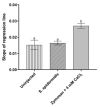A Bombyx mori Infection Model for Screening Antibiotics against Staphylococcus epidermidis
- PMID: 36005373
- PMCID: PMC9409246
- DOI: 10.3390/insects13080748
A Bombyx mori Infection Model for Screening Antibiotics against Staphylococcus epidermidis
Abstract
The increasing number of microorganisms that are resistant to antibiotics is prompting the development of new antimicrobial compounds and strategies to fight bacterial infections. The use of insects to screen and test new drugs is increasingly considered a promising tool to accelerate the discovery phase and limit the use of mammalians. In this study, we used for the first time the silkworm, Bombyx mori, as an in vivo infection model to test the efficacy of three glycopeptide antibiotics (GPAs), against the nosocomial pathogen Staphylococcus epidermidis. To reproduce the human physiological temperature, the bacterial infection was performed at 37 °C and it was monitored over time by evaluating the survival rate of the larvae, as well the response of immunological markers (i.e., activity of hemocytes, activation of the prophenoloxidase system, and lysozyme activity). All the three GPAs tested (vancomycin, teicoplanin, and dalbavancin) were effective in curing infected larvae, significantly reducing their mortality and blocking the activation of the immune system. These results corroborate the use of this silkworm infection model for the in vivo studies of antimicrobial molecules active against staphylococci.
Keywords: Bombyx mori; Staphylococcus epidermidis; antimicrobial compounds; dalbavancin; glycopeptide antibiotics; infection model; insect immune response; teicoplanin; vancomycin.
Conflict of interest statement
The authors declare no conflict of interest.
Figures






Similar articles
-
A Silkworm Infection Model for In Vivo Study of Glycopeptide Antibiotics.Antibiotics (Basel). 2020 Jun 4;9(6):300. doi: 10.3390/antibiotics9060300. Antibiotics (Basel). 2020. PMID: 32512807 Free PMC article.
-
In Vivo Efficacy of a Nanoconjugated Glycopeptide Antibiotic in Silkworm Larvae Infected by Staphylococcus aureus.Insects. 2024 Nov 13;15(11):886. doi: 10.3390/insects15110886. Insects. 2024. PMID: 39590485 Free PMC article.
-
Insect cytokine paralytic peptide (PP) induces cellular and humoral immune responses in the silkworm Bombyx mori.J Biol Chem. 2010 Sep 10;285(37):28635-42. doi: 10.1074/jbc.M110.138446. Epub 2010 Jul 9. J Biol Chem. 2010. PMID: 20622022 Free PMC article.
-
Discovery of anti-viral molecules and their vital functions in Bombyx mori.J Invertebr Pathol. 2018 May;154:12-18. doi: 10.1016/j.jip.2018.02.012. Epub 2018 Feb 14. J Invertebr Pathol. 2018. PMID: 29453967 Review.
-
A comparative review of the lipoglycopeptides: oritavancin, dalbavancin, and telavancin.Pharmacotherapy. 2010 Jan;30(1):80-94. doi: 10.1592/phco.30.1.80. Pharmacotherapy. 2010. PMID: 20030476 Review.
Cited by
-
Alternatives to animal models to study bacterial infections.Folia Microbiol (Praha). 2023 Oct;68(5):703-739. doi: 10.1007/s12223-023-01084-6. Epub 2023 Aug 26. Folia Microbiol (Praha). 2023. PMID: 37632640 Review.
-
Identification of Multifunctional Putative Bioactive Peptides in the Insect Model Red Palm Weevil (Rhynchophorus ferrugineus).Biomolecules. 2024 Oct 19;14(10):1332. doi: 10.3390/biom14101332. Biomolecules. 2024. PMID: 39456265 Free PMC article.
-
Silkworm and Silk: Traditional and Innovative Applications.Insects. 2022 Nov 3;13(11):1016. doi: 10.3390/insects13111016. Insects. 2022. PMID: 36354840 Free PMC article.
References
-
- Richmond J. The 3Rs–Past, present and future. Scand. J. Lab. Anim. Sci. 2000;27:84–92.
Grants and funding
LinkOut - more resources
Full Text Sources

